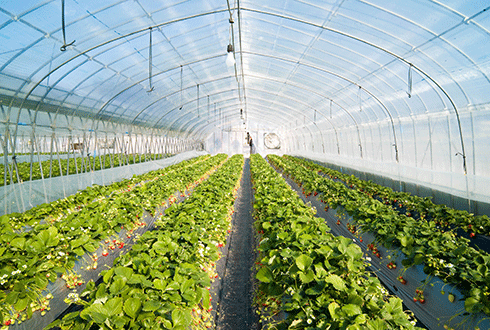
|
Published: 13 May 2014
What is climate sensitivity? How much humans add to the greenhouse effect
Humans are emitting CO2 and other greenhouse gases into the atmosphere. As these gases build up they trap extra heat and make the climate warmer. But how much warmer? Two of Australia’s leading meteorologists explain how the greenhouse effect works.

|
|
Scientists agree that the ‘enhanced’ greenhouse effect, due to human influence on climate, has increased. But how much warmer does each unit of CO2 make the Earth’s atmosphere? Credit:
Tldtld/Wikimedia Commons under CC-BY-2.0
|
Scientists have long understood that CO2 concentrations in the atmosphere contribute to the Earth’s natural greenhouse effect. This understanding pre-dates the 20th century, and was based on the fundamental science of radiation during the 1800s. A quick study of the geological record confirms this link: in the recent record, past atmospheres with high CO2 concentrations have always been warmer.
As our understanding of the enhanced greenhouse effect – which is due to the human influence on climate – has increased, it has become something of a scientific imperative to work out the relationship between CO2 and warming. How much warmer does each unit of CO2 make the Earth’s atmosphere?
This relationship between CO2 and warming is known as the climate’s ‘sensitivity’ to CO2. Determining climate sensitivity helps us understand our future risks and plan for future climate change.
The climate system is extremely complicated, as is the way humans affect it. To understand the basic processes we simplify the system and consider two different measures of sensitivity.
These measures are called ‘transient climate response’ and ‘equilibrium climate sensitivity’. The transient climate response is a measure of how much warmer the climate will get when it is still being pushed by human activity. The equilibrium response shows what the end result is hundreds of years down the track.
Transient climate response
The transient climate response is defined by how much the global mean temperature would rise if we were to elevate the CO2 content of the atmosphere by 1 per cent each year, compounded, from pre-industrial levels (ie 280 parts per million) to double that value. At that rate of increase, this would take 70 years.
This measure of sensitivity tells us how much the atmosphere would warm under these circumstances.
It is important to note that the sensitivity to double CO2 is not a climate change ‘projection’: scientists aren’t saying this doubling will actually happen in this way. Rather, it is a simplified technique used by scientists to understand how temperature might respond to rising CO2 levels.
The transient climate response is therefore not directly comparable to the climate projections that the IPCC or other bodies have released.
One can think of sensitivity to double CO2 as analogous to human sensitivity to a standard, measured dose of a particular prescription drug. Once we know how we react to one dose, we can infer how we might react to more of the same drug.
Equilibrium climate sensitivity
The transient climate response only tells us part of the picture – the amount of warming at the instant CO2 concentrations have doubled. However, different parts of the climate system warm at different rates. For example, the atmosphere warms much faster than the oceans.
The oceans average nearly 4 kilometres in depth and cover more than three-quarters of the Earth’s surface. That’s a colossal amount of water – 1.3 billion cubic kilometres, by most estimates. Hence, the oceans will take a very long time to warm up.
Both climate models and real-world observations show us is that the deeper reaches of the oceans are only beginning to warm in response to elevated CO2 (see here and here). They will continue to do so for hundreds of years. In other words, the oceans are not in equilibrium with the atmosphere.
The transient climate response, then, is the warming that the planet experiences once CO2 levels have doubled, but long before temperature equilibrium between the oceans and the atmosphere is attained. The equilibrium climate sensitivity asks how much warming would occur if CO2 remains at twice the initial level and we wait until the atmosphere and the ocean come into temperature balance.
Going back to our medical analogy, the equilibrium response is equivalent to how one should feel after the treatment with a prescribed drug has run its entire course.
In the climate system, this can take hundreds, if not thousands, of years.
The equilibrium climate sensitivity should be larger than the transient climate response because the warming occurs over a much longer period, and the climate has time to fully respond to the increased CO2.
Estimating climate sensitivity
There are several ways to estimate climate sensitivity. We can use:
-
climate models. These are mathematical representations of the climate system, based on the laws of physics and chemistry. They contain our best understanding of the physical processes that operate in the atmosphere, oceans, land surface and cryosphere (snow and ice)
-
information from distant past climates, such as from the last ice age. Paleoclimate reconstructions can reveal how Earth’s climate reacted to natural ‘pushes’, such as changes in the planet’s orbit, and associated changes in CO2
-
data on how Earth responds to the short, sharp climate push it gets from large volcanoes. For instance, in 1991 Mt Pinatubo spewed millions of tonnes of particles into the atmosphere, reflecting back some incoming sunlight and resulting in a two or three year dip in the Earth’s temperatures<<li>recent climate trends. This helps us evaluate how much the climate has warmed over the last 50 years in response to the CO2we’ve already emitted.
Putting it all together
Every six years or so the Intergovernmental Panel on Climate Change (IPCC) exhaustively examines all lines of evidence, and puts them together to give its best estimate of how sensitive our climate is to increasing levels of greenhouse gases in our atmosphere.
IPCC reports in 1990, 1992, 1995, 2001, and the recent report in 2013, all estimated a likely range of equilibrium climate sensitivity of 1.5°C to 4.5°C (although the 2007 report modified it slightly to 2.0°C to 4.5°C). This shows a remarkable consistency over more than 20 years.
This means if we kept CO2 levels at twice initial levels, then waited the hundreds of years for heat in the atmosphere and ocean to balance, the overall warming would be between 1.5°C and 4.5°C.
The transient climate response is estimated at around 1.0°C to 2.5°C. This means if we increase atmospheric carbon dioxide from pre-industrial levels by 1 per cent a year until it is doubled (which will take 70 years), we can expect the climate to warm by between 1°C and 2.5°C.
What does this mean for global warming?
Measures of climate sensitivity allow scientists to readily compare climate models with each other and with observed changes. And because equilibrium climate sensitivity has been in use for more than 30 years it can help us track how our estimates have changed over time.
But climate sensitivity does not directly tell us what temperature changes we might expect over the next century.
The best guide for future warming is provided by projections from the current generation of climate models. They indicate warming will depend strongly on the level of future emissions, under different ‘scenarios’.
For a high-emission scenario (‘business as usual’), CO2 levels increase to more than 900 parts per million by 2100, compared with pre-industrial levels of 280 parts per million. Under this scenario, models project an end-of-century warming of 3.2°C to 5.4°C above an 1850–1900 baseline.
For a low-emission scenario, under which CO2 levels peak then decline to 420 parts per million, models project warming of 0.9°C to 2.3°C by 2100.
Dr Rob Colman is a Principal Research Scientist at the Bureau of Meteorology, which operates under the authority of the Meteorology Act 1955 and provides Australians with environmental intelligence for their safety, sustainability, well-being and prosperity. Dr Karl Braganza currently heads Climate Monitoring at the Bureau of Meteorology's National Climate Centre. This article was originally published on The Conversation.



